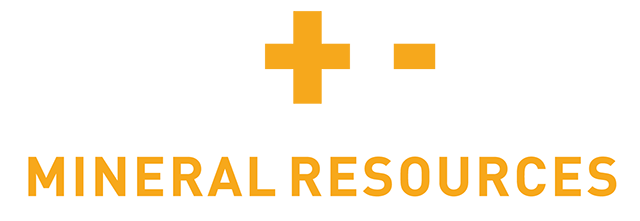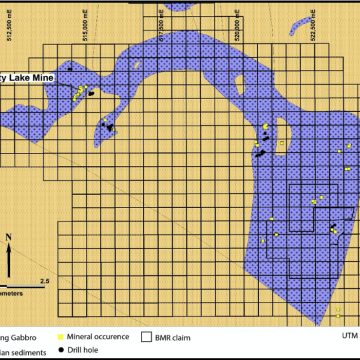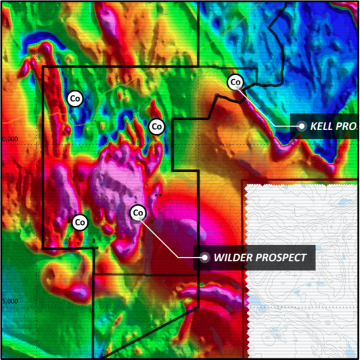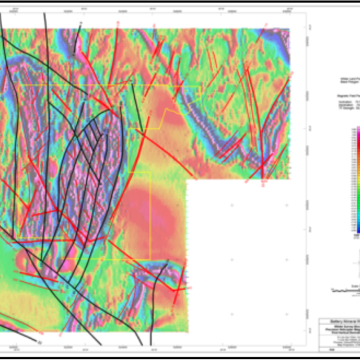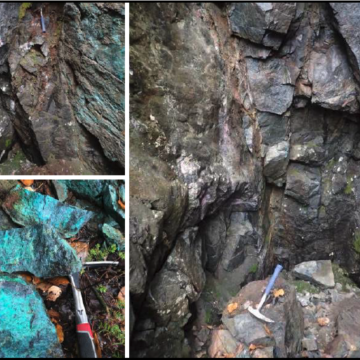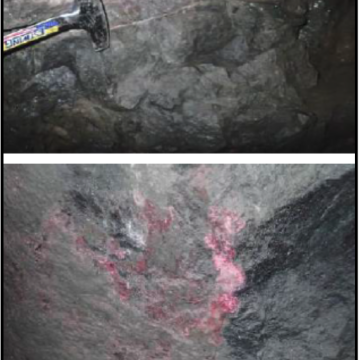Wilder
Key Facts
Overview
BMR's Wilder project comprises a Nipissing Gabbro sill that hosts a past producing mine and numerous Five-Element vein style mineral occurrences that contain anomalous Cobalt. The size and geometry of this Nipissing Diabase sill are like ore-hosting sills at the established Historic Cobalt and Gowganda mining camps.
Historically, significant Silver and Cobalt values were obtained from the Wilder adit, the Thompson- Lundmark shaft area and the Rusty Lake mine area (no 1, 2 and 4 shafts), the latter having produced 80,186oz of silver and 565 pounds of Cobalt from the main shaft No 3) between 1936 and 1966.
A number of pits, shafts and adits were located and investigated by BMR during prospecting traverses conducted between 2018 and 2021. Grab samples from the rock piles around some of the minor shafts returned Cobalt assays as high as 0.65%.
Historical Background
Exploration at Wilder commenced in 1911 when local prospector Frank Wilder excavated an 8m x 2m trench that exposed a narrow, mineralized calcite vein.
In Leith Township, the historical Rusty Lake Mine (formerly Hudson Bay Silver Mine, Silver Gowganda and Silver Valley Mine), was in operation from 1910 to 1968. There are some conflicting reports on the production history of the mine, but 80,000 ounces of Silver and 565 pounds of Cobalt were reported from 1910 to 1968 (Mcilwaine,1971).
1926 -1927: A 15m vertical shaft was sunk and 320m of drifting developed from an adit. Silver-Cobalt – Nickel mineralization reported from the bottom of the shaft.
1960: Geologic mapping, sampling of veins in drift and geophysical surveys were conducted. This work traced a narrow (5cm-12cm) calcite vein with Erythrite (Cobalt oxide) over a strike length of 70m in underground workings. Vein Samples assayed 406g/t Silver and 909g/t Silver.
1978 - 1981: Local prospectors opened a trench from which 145 ounces Silver were recovered from Calcite veins. A channel sample of disseminated mineralization from the trench assayed of 688g/t Silver over 3.3m and one rock grab sample from the trench assayed 6.0% Cobalt.
1981: A rock grab sample from the Brady-Wilder trench assayed 1.4% Cobalt, 0.9% Nickel and 6,970g/t Silver. A second grab sample from the shaft assayed 5.7% Cobalt, 2.7% Nickel and 153g/t Silver.
Geology & Mineralization
The Wilder project comprises variably exposed Huronian Supergroup metasediments and Nipissing Diabase intrusions. Huronian rocks in the project area belong to the Gowganda and overlying Lorrain Formations.
In the central portion of the property the Nipissíng Diabase hosts a cluster of 5 Cobalt showings. Most of the prospective Nipissing-Huronian contact remains untested by drill holes.
The Wilder project is situated within a regional scale fault system that is spatially associated with the nearby Juby gold deposit and the gold deposits in the Swayze belt (including the Côté deposit) to the west.
Current Exploration
Wilder is considered by BMR as highly prospective for hosting high-grade Five-Element vein style mineralization because of the regional structural setting and metal endowment.
Much of the project area is covered by a relatively thin layer of sand and glacial till which has made traditional prospecting techniques unsuccessful in discovering new bedrock deposits. However, BMR sees this as an opportunity to deploy modern tools and techniques (e.g., geophysical data collection and processing) alongside its geological database to discover new, covered deposits in this underexplored area.
BMR’s exploration effort to date includes an airborne magnetics and radiometrics survey, a LIDAR topography survey and two grid-based geophysical three-dimensional distributed induced polarization (“3D IP”) surveys.
Geological mapping, rock sampling and prospecting work has been focused on the known Cobalt occurrences in the central portion of the Wilder property. Encouraging rock grab sample results include;
- 0.09% Cobalt (R0029)
- 0.65% Cobalt (R0030)
- 0.01% Cobalt, 48.90 g/t Silver and 0.91% Copper (R0401)
- 0.06% Cobalt, 5.00g/t Silver and 0.09% Copper (R0601)
- 0.65% Cobalt, 12.90g/t Silver and 0.06% Copper (R0626)
Ground follow-up exploration work to develop drill targets is ongoing.
Technical Report
February 5, 2021: Technical Report on Cobalt Exploration Assets in Canada prepared for Battery Mineral Resource Corp. prepared by SRK Consulting (Canada) Inc.
